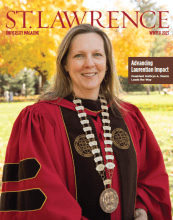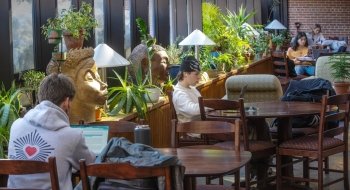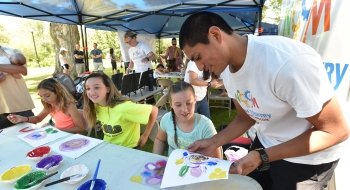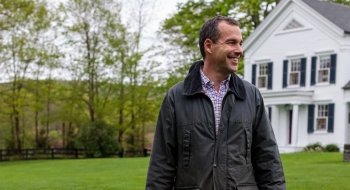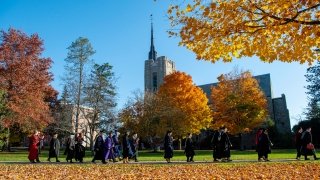
A Framework for the Future
President Morris reflects on the accomplishments of the St. Lawrence University community since her inauguration and shares her strategic framework for the future.
By the time Kathryn A. Morris was officially inaugurated as the 19th president of St. Lawrence University on a sparkling October morning, she had already provided 16 months of leadership and service to the Laurentian community.
Although she took the helm in July 2021, the formal investiture ceremony, like so much else, had to be postponed because of the COVID-19 pandemic. Standing before trustees, faculty, students, parents, alumni, staff, and local citizens gathered in Gunnison Memorial Chapel, Morris spoke with the insights of an insider, a Laurentian who has immersed herself in the campus culture and Laurentian traditions.
“St. Lawrence has a long history of success, a long list of points of pride, and a steadfast commitment to our institutional mission,” she told the crowd. “Yet since our founding in 1856, St. Lawrence has always been in the process of becoming.”
During her time as president, Morris has traveled near and far, discovering what is important to Laurentians, and experiencing some of what makes St. Lawrence special. She’s enjoyed theatre productions, cheered on the Saints at athletic contests, and served up cookies for students during late-night study breaks during finals week. She’s toured the sites of Kenya Semester internships focused on mitigating the effects of climate change, visited students in the New York City Semester and met with young alumni entrepreneurs, from Burlington to San Francisco.
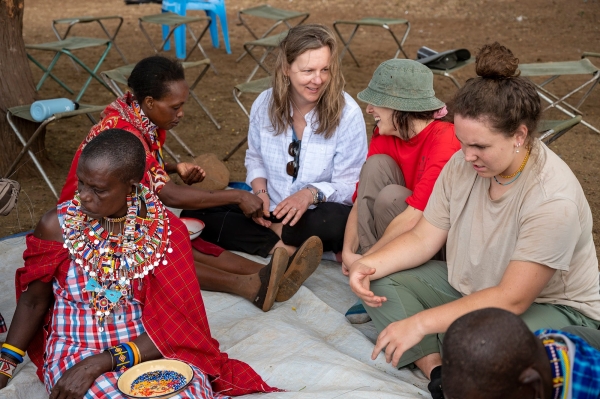
“St. Lawrence has gone through a significant evolution over the past two years,” Morris observes.
In addition to the presidential transition and several other leadership transitions, St. Lawrence launched six new academic majors—data science, finance, public health, biomedical sciences, pre-health chemistry, and digital media and film—and also added esports to the roster of varsity sports. The last two years included a reimagining of the Center for Career Excellence which harnesses St. Lawrence’s top-ranked alumni network and provides students with campus resources and events to maximize their post-graduation preparedness.
Morris has also picked up the reigns of substantial wellness initiatives that address the pressing mental health concerns for youth and college-age populations. With the University’s partnership with the nonprofit JED Foundations’ JED Campus assessment and programming, St. Lawrence has already begun to capitalize on new opportunities to build wellness infrastructures across constituencies.
All of these efforts have been bolstered by Morris’ cultivation of over $30 million in new gifts and commitments from Laurentians since she started in July 2021.
“Even with these recent changes and initiatives, we are never done evolving,” says Morris. “As we look to the future, we need to continue to contemplate, develop, and implement new initiatives to ensure St. Lawrence continues to thrive as a relevant, competitive, and strong university.”
Strategic Framework
Morris knows from her past 26 years in higher education the importance of creating strategic plans that are both aspirational and actionable, and that are authentic to the institution. She has worked hard to build consensus in drafting a new framework for the future.
“We’re building a strategy that’s easy to communicate and that is flexible, identifying a few specific initiatives that we can focus on at any point in time,” she says. Three strategic initiatives she is prioritizing this year include expanding what Morris calls “Laurentian Impact,” launching a new Center for the Environment, and supporting community well-being.
Laurentian Impact
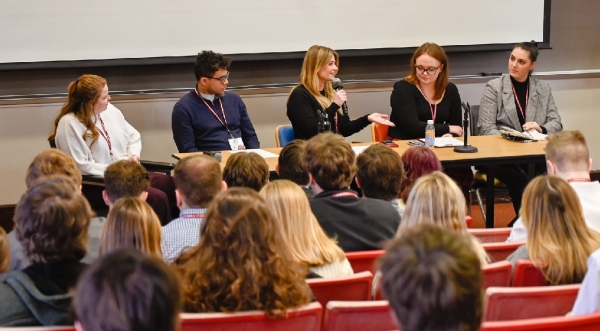
“A lot of schools are talking about career preparation for students,” says Morris. “This is a part of the value proposition that students and parents are interested in, especially as they’re thinking about spending quite a bit of money on their college students’ education.”
She and her husband, St. Lawrence psychology professor Brian Giesler, can relate: their daughter is currently in college and their son just graduated. Good placement in graduate school, service-oriented programs, and jobs are all part of the return on investment families have come to expect, and St. Lawrence scores high on these outcomes measures: 94 percent of recent graduates are employed or enrolled in advanced-degree programs within seven to nine months of graduating.
Yet Morris believes job placement is just the beginning, and articulates the distinction between initial post-college outcomes and Laurentian Impact this way: “Laurentian Impact is what happens when St. Lawrence graduates use what they learned in college to make a positive difference in the world after graduation. It’s about empowering students to discern their passions, to develop their sense of purpose, and to use their educational experiences in college to build futures that not only ensure our graduates can make a living, but also to make a life that is meaningful and that positively impacts others through their professional work, volunteer activities, or civic engagement.”
Over the past several years, and thanks in large part to a generous $3 million gift from Hilary Ayn Valentine ’89, the University has made significant investments in its Center for Career Excellence (CFCE). In addition to personalized career coaching and planning, the CFCE facilitates signature programs that empower students to leverage their unique liberal arts experiences for career preparation. Some of these programs include one-on-one alumni mentoring, week-long networking trips to employment centers across the country, and career prep courses and workshops.
“Everything our students do during their time here—from research with their faculty mentors to the time they spend studying off campus to their co-curricular commitments and volunteer work in our community, will help them identify how they can make a real impact on the world after graduation,” Morris says. “St. Lawrence’s vast network of ultra-engaged alumni (ranked No. 4 in the nation this year by The Princeton Review) makes all the difference,” Morris continues.
Many alumni are not only doing important work in their own communities and the world at large, but they are also getting involved in LINC (Laurentians Investing In Networking Connections) programs and other mentoring efforts with students and young alumni. SLU Connect events are another great example. These programs are held in competitive job markets across the country, from Boston, New York City and Washington, D.C., to Big Sky, Montana, and San Francisco, and allow students to attend industry-based roundtable discussions, company site visits, and networking events while getting an up-close view of alumni purpose in action. Morris intends to grow these programs, and to invite more alumni to take part in them: “I am confident that together, our combined Laurentian Impact will reach farther and wider than ever before in the history of our institution,” Morris says.
Center for the Environment

The Center for the Environment is an idea that has been discussed for some time, and President Morris is developing a plan to turn the idea into a reality.
“This Center will capitalize on our unique location between the Adirondack mountains and the St. Lawrence River. It will be for our students, and for all of our students,” Morris says. “Whether they’re majoring in environmental studies, English, biology, geology, data science, finance, performance and communication arts, public health, business in the liberal arts, or any other program, students across this campus care deeply about the environment, climate issues, sustainability, and other topics in this sphere.”
In 2023, the University will hire the Center’s executive director who will oversee experiential programs, student development, and sustainability efforts, while coordinating outposts—like the University’s Kenya campus—and community engagement.
Morris has proposed five pillars to lift the emerging concept, beginning with identifying ways to leverage existing experiential programs (Adirondack Semester, Sustainability Farm, Kenya Semester, and Nature Up North, to name a few) and new opportunities to offer students a suite of immersive educational experiences to learn about and engage with environmental topics.
Secondly, Morris would like to see the Center tackle the big questions, funding faculty and student research, service projects, arts and creative projects, or relevant work in disciplines that relate to environmental initiatives. She sees the potential for larger grants to be secured through the Center from national foundations to study a range of things like rural waterways or migration patterns of Maple trees, or other regionally specific studies that could inform local, state, national, and international policy.
The third pillar addresses student development, exploration of new green jobs, public policy, and activism.
“We need to help our students understand what’s potentially out there and give them the experiences on and off campus to make sure that they are prepared for jobs related to the environment and to be effective advocates for sustainability and mitigation of climate change,” says Morris. The final pillar involves supporting St. Lawrence’s new sustainability coordinator in our campus sustainability efforts, giving students experiential opportunities to engage with those sustainability efforts, and helping to reimagine existing assets and programs to maximize opportunities. Morris is eager to see St. Lawrence make progress toward our sustainability goals and commitments.
Community engagement and outreach constitute the final pillar.
“What could Canaras’ role be?” she asks. “How could the fact that we have a campus in Kenya be involved as an outpost of the Center for the Environment? Are there other outposts we could consider? How could we partner with our North Country community members to address environmental challenges here?”
The foundation of the Center for the Environment will be the people: faculty and staff experts, student fellows, an external advisory council, and a newly created position of executive director to help lead the coordination of stakeholders involved with the Center. Donors have already contributed $2.5 million for the Center.
Morris says: “I want to inspire people to expand on what a Center can be and how it can serve our community, serve our students, and serve the world.”
Community Well-being
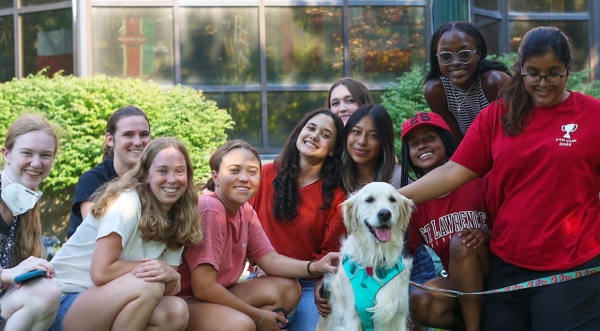
The wellness initiative can be illustrated by a VEN diagram in which students, faculty, and staff intersect.
“There are ways that wellness programming can overlap,” says Morris. “Walking and fitness activities and mindfulness are things that will work for both students and employees, but otherwise they’re different populations that require different initiatives in terms of how to support well-being holistically.”
Parents and educators at all levels are on the front lines in combatting an enormous spike in mental health challenges for children and young adults. St. Lawrence has prioritized fundraising to support student mental health and has received significant support to expand services.
Jan Egbers P’21 made a $1.5 million gift in 2022 to create an endowment supporting St. Lawrence health and counseling services, with a focus on the emotional wellness of student-athletes. In accordance with Egbers’ wishes, the fund also honors the long-time (now retired) Head Golf Coach Mary Lawrence by naming her former position the Mary A. Lawrence Head Coach for Men’s and Women’s Golf.
The Thelomathesian Society (“Thelmo”) donated $1 million of budget surplus to create an endowed fund aimed at increasing the availability of student mental health care on campus. It is an unprecedented gift, forged in part by two years of underspending on student activities due to pandemic restrictions.
“We can do a lot with wellness and prevention, in particular, by working with students to foster a sense of belonging on campus to build their interpersonal and professional skills,” says Morris. “By prioritizing wellness as an integrated part of campus life and programming, we can foster greater emotional confidence and resiliency.”
By prioritizing wellness as an integrated part of campus life and programming, we can foster greater emotional confidence and resiliency.”–President Morris
Assessing how to do that specific to the St. Lawrence culture and campus resources is why the JED Foundation partnership is key. JED Campus assessments specialize in substance abuse programming and suicide prevention, but also make recommendations on holistic wellness initiatives specific to each institution. The Student Life division is continuing to refine the conversation and design opportunities for more social engagement, additional healthcare programs, and tools like free access to smartphone apps that foster healthy habits, both physical and psychological.
And there are now more resources to support well-being for faculty and staff, plus a faculty-staff wellness coordinator to oversee programming. In addition, the University’s Employee Assistance Provider (EAP) began offering in the fall access to expanded virtual mental health services that include video, live chat, and text-based coaching and counseling, as well as mindfulness resources and guided meditations.
Morris sees wellness as a key ingredient to fulfilling the University’s mission and maximizing Laurentian Impact: “It’s about being human beings.”
The “Next Best Version of Ourselves”
As the University’s 19th president, Morris has embraced her opportunity to turn our collective attention to the future, to contemplate what we can become, together, as Laurentians. She has confidence the three initiatives identified for intentional focus this year— Laurentian Impact, Center for the Environment, and Wellness—will shape St. Lawrence far into the future, while amplifying the University’s core qualities.
“Across our 166-year history, many important characteristics of the University have remained constant—our mission, our commitment to academic excellence in the liberal arts, and our many institutional traditions,” says Morris. “While our grounding in our foundational values remains steadfast, we are always becoming the next best version of ourselves.”

